|

WildLife
Andhra Pradesh occupies a strategic
position in the Indian subcontinent. Its varied topography from high
ranges of the Eastern Ghats and the Nallamalai to the shores of Bay of
Bengal, has given rise to a variety of flora and fauna. The Eastern Ghat
ranges are found moist to semi-evergreen forests which give way to the
dry thorn scrubs of the Ananthapur plateau. This variation in turn has
given rise to varied fauna including tigers, panthers, wolves, etc. NELLAPATTU
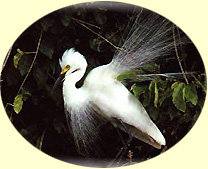 The
Nelapattu Bird Sanctuary is one of the largest pelican habi- tats in
South-East Asia. More than 1,500 pelicans breed here every year apart
from it being a visting place for the migratory birds for a long time. The
Nelapattu Bird Sanctuary is one of the largest pelican habi- tats in
South-East Asia. More than 1,500 pelicans breed here every year apart
from it being a visting place for the migratory birds for a long time.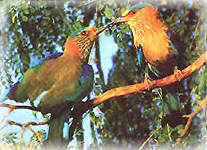
The sanctuary is a breeding ground for
rare and endangered species like grey pelicans, open-billed storks,
little cormo- rants, spoon-bills, white-ibises and night herons. It is
also an ideal roosting place for many birds like egrets, terns and
ducks. The trees here are ideally suited as perches. The people here,
young and old, take it as their responsibility and protect them from any
kind of disturbance. Nelapattu Bird Sanctuary is in Nelapattu village. Mahaveer Harina
Vanasthali National Park Located in
Vanasthalipuram, about 15 kilometers from the center of the town, the
Deer park is a tourist's attraction. It is maintained by the Forest Department and is not a part
of city-town.
attraction. It is maintained by the Forest Department and is not a part
of city-town. Once the Nizam's Shikargarh or hunting grounds, the Mahavir Harina
Vanasthali National Park, on the outskirts of Hyderabad, is today home
for a few hundred black buck along with several species of birds. The
deer park, has an undulating terrain, of 189 hectares dominated by
acacia trees. The park looks picturesque in the monsoon with the golden
and white flowers of these trees on the lush green carpet of grass. Antelope and the beautiful black bucks, which once inhabited the
grasslands and plains throughout India, are an endangered species now.
Their main predator was the now extinct cheetah. Their glossy white
dotted bodies, ranging from dark brown to black, accentuated by a white
underbelly, their large lustrous eyes and mouth surrounded by white, are
a study in contrast.
Mahaveer Harina Vanasthali National Park
provides the black buck its much needed safe haven to exist. It is also
home to a hundred species of birds, and pond herons, egrets,
kingfishers, cormorants can be sighted almost always. More lucky ones
can even watch black bucks, literally locking horns in a duel for a
score of beautiful does. Kawal
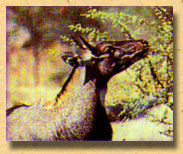 |
Location :
Adilabad district, Forest Division - Jannaram, 50km. from
Mancherial Railway Station.
Area : 893 Sq. Km.
Habitat : Dry deciduous
- teak forest, bamboo and other species.
|
Animals found :
Cheetal, Sambhar, Nilgai, Muntjac (Barking Deer), Indian Bison(Gaur),
Sloth Bear, Panther, Tiger and a large variety of birds. Accessibility :
The nearest railway station is at Mancherial. At about 260 km. by road
from Hyderabad, it is easily reachable by State owned bus
services. Nearest airport is at Hyderabad. Accommodation :
Forest rest house at Jannaram Season :November
to May. Sivaram
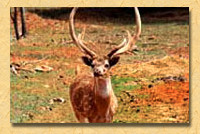 |
Location :The
sanctuary is located along the river Godavari in Adilabad and
Karimnagar districts. It is 50 km. from Mancherial in Adilabad
district.
Area : 36.29 Sq. km. in
both the divisions of Mancherial and Karimnagar (West).
|
Habitat : Riparian forests
along the river Godavari and occupies forest areas on both the river
banks mainly of deciduous type with mixed teak and bamboo. Animals found: Spotted Deer,
Sambhar, Nilgai, Monkeys, Langurs, Jackals, Wild Boars, Python, Sloth
Bear, Panthers and Tiger. The sanctuary is noted for the presence of
marsh Crocodiles in the river Godavari. Accessibility : The
sanctuary is approachable by road from Mancherial in Adilabad District
(50km.) and from Manthani in Karimnagar District (10km.). Accommodation: Forest rest house
at Mancherial at Eklaspur. Season : December to April. Pakhal Location :
- Warangal district, Narasampet - Warangal south division 60km. from
Warangal District head quarters.
Area :
860 Sq. km. Habitat :
Dry deciduous mixed type forests, bamboo and mixed teak forests. Animals found :
Spotted Deer, Sambhar, Nilgai, Wild Boar, Guar, Python, Wild Dogs,
Foxes, Jackals, Hyena, Sloth Bear, Panther, Tiger and Ducks, Teals,
Cormorant, Spoon Bills and Storks. Accessibility
: Nearest railway station is at Warangal, 130 km. by road from
Hyderabad. Well connected by State owned bus services. Accommodation
: Forest rest house at Pakhal. Season :
November to June. Pranahita
 Location
: District - Adilabad, Chinnur- Mancherial forest
division about 300 km. north east of Hyderabad. Location
: District - Adilabad, Chinnur- Mancherial forest
division about 300 km. north east of Hyderabad.
Area : 136.02
km.
Habitat : Dry
deciduous teak forest along Pranahita river, a tributary of
river Godavari with undulating terrain.
|
Animals found :
Cheetal, Black Buck, Nilgai, Sloth Bear, Panther, Tiger and a variety of
birds including Brahminy Ducks, Teals, Storks and Herons. Accessibility :
By road about 70 Km. from Mancherial. Nearest airport
- Hyderabad ( 300 km.) Accommodation
: Forest rest house at Mancherial and Chinnur. Contact :
Divisional Forest Officer, Mancherial. Season :
November to April. Eturunagaram
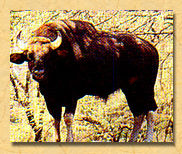 |
Location:District-Warangal,Mulag-Warangal
North Forest Division80km.from Kazipet Junction. (S.C.Railway)
and Warangal Town
Area : 803 Sq.
km. |
Habitat :
Dry deciduous mixed teak forest with bamboo & other species on
rolling countrysides with low hills. Animal found :
Spotted Deer, Black Buck, Sambhar, Nilgai, Chowsingha, Muntjac, Wild
Boar, Guar, Jungle Cat, Jackals, Foxes, Wolves, Sloth Bear, Panther,
Tiger and variety of other birds Accessibility
: Nearest Railway Station is at Warangal. By Road from
Hyderabad 130 km. Well connected by state buses. Accommodation :
Forest cottages at Tadvai and Eturnagaram. Contact :
Divisional Forest Officer, Wildlife Management , Warangal. Season
: October to May. Kinnerasani Location
: The sanctuary is located in Khammam District near Paloncha.
The sanctuary includes a big reservoir kinnersani. Area :
655.41 Sq. km. Habitat:
The sanctuary represents dry deciduous mixed type forests with teak,
bamboo and terminals and the picturesque Kinnersani reservoir. Animals found :
Cheetal, Black Bucks, Chinkaras, Chousinghas, Sambhars, Wild Boars,
Gaurs, Wild Dog, Hyena, Jackals, Sloth Bear, Panthers, Tigers, and a
variety of bird species like Peafowl, Jungle Fowl, Qualis, Partridges,
Doves, Ducks, Teals, Spoonbills, Nuktas, Open bill stork, come to nest
and graze in Kinnersani lake and there are number of water pools in the
interior forest areas. Muggers are also found in the reservoir. Accessibility: Nearest Railway
Station is at Bhadrachalam Road which is about 25km. from kinnersani. Accommodation:
Forest rest house at Paloncha and Kothagudem . Season: October
and June. Papikonda Location: The sanctuary
is located on the left and right banks of river Godavari as it cuts
through the Papikonda range of the Eastern Ghats. Area: 591 sq.km. Habitat: The dry
deciduous mixed forest with bamboo is found extensively in the
sanctuary. The habitat is suited for Tigers, Gaurs and other herbivore
animals. River Godavari runs through the middle of the sanctuary on the
hill tops and steep slopes. Animals found:
Spotted Deer, Four Horned Antelope, Sambhar, Gaurs, Hyena, Jackals. The
presence of gharials were also reported. Variety of birds both resident
and migratory are found along river Godavari and its tributaries. Accessibility:
Nearest railway station is at Rajahmundry. Accommodation:
Forest rest house at Rajahmundry, Maredmilli and Kannapuram. Season: October
to May. Top
|



